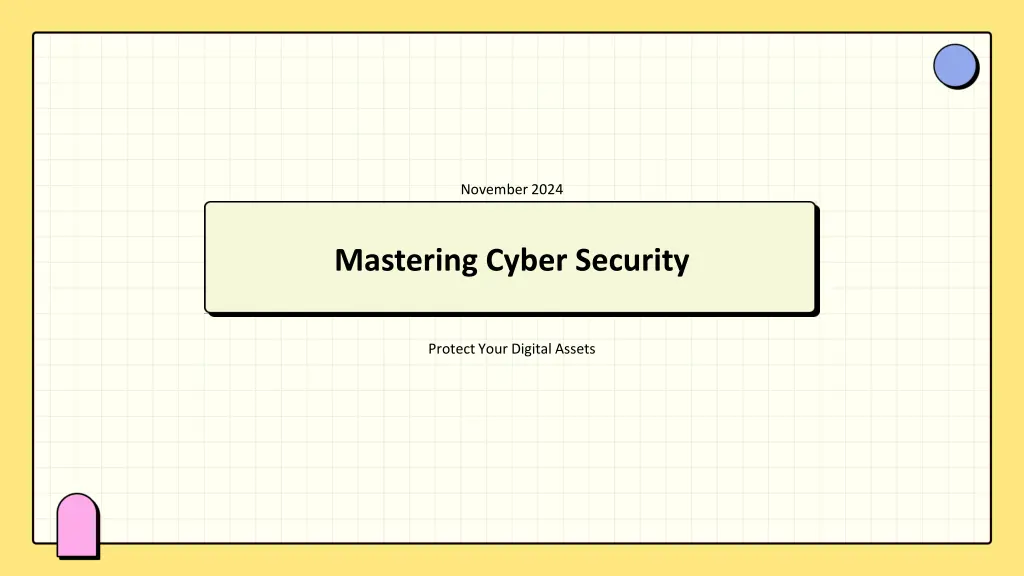
Mastering Cyber Security: Safeguarding Digital Assets in November 2024
Explore the crucial elements of cyber security such as the evolving threat landscape, impacts on organizations, core security principles, frameworks and standards, and the role of technology. Understand the importance of cyber security awareness and incident response planning to protect your digital assets effectively. Join us in mastering cyber security to ensure a secure digital environment for your organization.
Download Presentation

Please find below an Image/Link to download the presentation.
The content on the website is provided AS IS for your information and personal use only. It may not be sold, licensed, or shared on other websites without obtaining consent from the author. If you encounter any issues during the download, it is possible that the publisher has removed the file from their server.
You are allowed to download the files provided on this website for personal or commercial use, subject to the condition that they are used lawfully. All files are the property of their respective owners.
The content on the website is provided AS IS for your information and personal use only. It may not be sold, licensed, or shared on other websites without obtaining consent from the author.
E N D
Presentation Transcript
November 2024 Mastering Cyber Security Protect Your Digital Assets
Table of Contents 5 The Role of Technology 1 The Cyber Threat Landscape 6 Cybersecurity Awareness 2 Impact on Organizations Core Elements of Cyber Security 7 Incident Response Planning 3 Security Frameworks and Standards 8 Future Trends in Cyber Security 4
9 Thank You for Joining Us!
The Cyber Threat Landscape 1. Cybersecurity encompasses safeguarding organizations against ever-evolving cyber threats and attacks. 2. With the increasing dependence on technology, understanding the landscape of potential threats is crucial. 3. Organizations must identify vulnerabilities to implement effective strategies to mitigate risks. Photo by Pexels 4. From malware to phishing, acknowledging various cyber threats is the first step to protection.
Impact on Organizations 1. A cyber threat can lead to devastating repercussions for repercussions for organizations, including financial losses. financial losses. 2. Data breaches compromise sensitive information, leading to legal liabilities and reputational damage. 3. Downtime from cyber attacks can halt operations and disrupt productivity, affecting bottom lines. Photo by Pexels 4. Investing in cybersecurity is not just an option; it s a business necessity to ensure longevity.
Core Elements of Cyber Security 1. Cybersecurity involves multiple layers of protection protection spread across networks, devices, and programs. 2. Implementing firewalls, encryption, and intrusion detection are essential to combat threats. 3. Training employees on security best practices strengthens organizational defenses. Photo by Pexels 4. A comprehensive strategy encompasses technology, people, and processes working in harmony.
Security Frameworks and Standards 1. Utilizing established frameworks like NIST, ISO, and CIS and CIS helps organizations develop robust cybersecurity cybersecurity strategies. 2. These frameworks provide guidelines and best practices for risk management and compliance. 3. Adopting standards ensures a structured approach to assessing and improving security postures. Photo by Pexels 4. Frameworks enhance collaboration among teams and streamline incident response efforts.
The Role of Technology 1. Advanced technologies like AI and machine learning are learning are revolutionizing cybersecurity practices. practices. 2. Automated threat detection and response systems enhance organizations' ability to act swiftly. 3. Cloud security solutions offer scalable protection for businesses leveraging online resources. Photo by Pexels 4. Investing in cutting-edge technology can provide critical advantages against cyber threats.
Cybersecurity Awareness 1. Employee education on cybersecurity threats fosters a fosters a culture of vigilance within organizations. 2. Regular training programs ensure that all staff members are aware of potential risks. 3. Phishing simulations and security drills can reinforce response mechanisms effectively. 4. Empowered employees become the first line of defense Photo by Pexels against cyber attacks.
Incident Response Planning 1. An effective incident response plan outlines clear steps to steps to take during a cyber incident. 2. Regularly testing and updating response plans ensures readiness when real threats occur. 3. A rapid response can minimize damage and recover lost data swiftly. 4. Preparedness enhances confidence and reduces the Photo by Pexels overall impact of potential attacks.
Future Trends in Cyber Security Security 1. As technology evolves, so do cyber threats, making future making future security practices paramount. 2. Emerging technologies like quantum computing will necessitate new protective measures. 3. Organizations must remain adaptable and proactive in their security approaches. 4. Staying ahead of trends is essential for sustaining a secure Photo by Pexels environment.
Thank You for Joining Us! 1. We hope this presentation highlighted the critical aspects aspects of cybersecurity for all organizations. 2. Your awareness and proactive measures can significantly impact your data security. 3. Together, let's build a safer digital world for everyone. 4. Thank you for your attention and commitment to cybersecurity! Photo by Pexels
